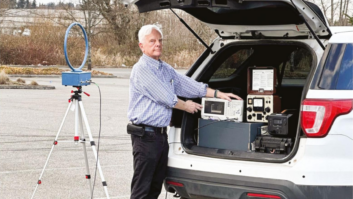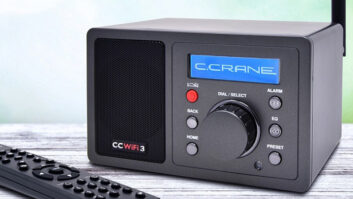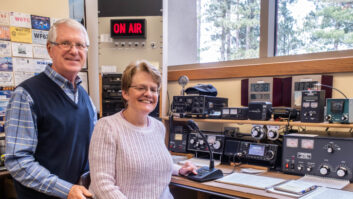Built solid
Dec 1, 2006 12:00 PM, By Kent Kramer and Marshall Rice

Furniture determines growth potential for additional technology and often times has to last longer than any other piece of equipment in the room. In today’s radio station it may also have to support on air and production operations for multiple formats. The furniture must also accommodate the needs and preferences of individual talent.
While the furniture determines the growth potential of the room, conversely, the room will also dictate the type and style of furniture used. Building the room solely for the task for which it is meant serves the immediate need, but considering possibilities many years down the road can prevent the installation from being built into a corner.
Options overview
There are three basic styles of broadcast furniture: knock down, custom built and custom built by a mill worker.
If your budget is the prime consideration in your choice of furniture, you will probably fall into the knock down type of furniture. This type of furniture can also be the most flexible if it is installed in a multi-use room.
The knock-down style is a popular choice because it can be shipped via overnight freight. Repairs, modifications and new parts can arrive quickly to allow for quick reconfigurations. Only the largest pieces, usually the counter tops, may have to ship via truck line.
Knock down is a great foundation for start-up facilities. It can look just as nice as more expensive furniture and be most any color that fits the facility.
There are, however, some limitations to stock furniture. First, it may be more difficult to put it in an existing room. Available sizes may not fit perfectly given the room size and layout, and it may have to be placed against a wall, which makes equipment access more difficult. Also, any small custom changes may cost a premium to implement. Knock down furniture also leaves a considerable amount of debris behind. Because it ships via common carriers, it has to be packaged to be well protected in transit.
Depending on your schedule and ability, one obstacle may be the assembly required for this style. This can be a daunting task but once it’s done it’s a rewarding feeling.
Going custom

Pull-out mounts provide simplified front-of-rack access to equipment
The second type of furniture is custom built to the room. If the room is really small or if you want a customized look and feel, this might be the right direction for you.
While this furniture still uses some quick-built tactics, the furniture is customized to the room dimensions. This flexibility adds time and effort to the design process, but rack placement, equipment turrets and cable access can be placed almost anywhere it is needed.
Delivery of this type of furniture is usually handled by factory personnel and installed in a matter of days. Minor scratches can be touched up and the furniture is factory fresh when the crew leaves. The installers will probably drill all the needed access holes for cable penetrations while on site as well.
Another benefit of this furniture is the use of multiple types of materials for countertops. Corian by Dupont is one common material, but there are other solid-surface types that are similar. The joints can be welded so that they are nearly, if not completely, invisible. The tops can be resurfaced in the future and holes can be patched when it becomes necessary to modify the room. The repair, such as the sanding and buffing process, can be quite messy but the result is an almost-new top.
The budget will need a bit more money to go this route because the delivery will add significantly to the price. Add more to the cost if the installation crew has to stay for a few days.

A variety of flat-panel monitor mounts exist, such as this one from Yellowtec.
A second version of this method is custom-built furniture from a local cabinet maker. This route will also provide exactly what you want, and it may cost less than a broadcast furniture maker, but it will probably be necessary to educate the mill worker on the standards for equipment rack sizes. While this is not a major issue and can be done, it might pay to have the cabinet maker take some measurements and an inside look at some existing studio furniture to make sure he fully understands what happens inside a radio studio. Running studio wiring is different than what happens under kitchen cabinets.
The final option is custom built by a mill worker/cabinet maker. This is similar to the variation above, but this applies specifically to one-of-a-kind furniture. An architect often is involved prior to the woodshop getting involved. This type of furniture will probably have a room built around it. It will generally be a focal point of a showcase facility.
The materials will generally be high quality and the budget is probably wide open for furniture.
There are a lot advantages and disadvantages to a piece of furniture like this. On challenge is that every opening, access panel, grommet and jack must be considered prior to construction. While these can be added later, putting them in during the construction will make sure that everything fits once it’s in place and access is ensured where it’s needed. The designer can also fit the facility’s needs into the design to maintain the aesthetics of the furniture.
Built solid
Dec 1, 2006 12:00 PM, By Kent Kramer and Marshall Rice
What’s inside?
Studio equipment has evolved dramatically in the past few years. Consoles are now control surfaces. Audio is delivered primarily via computers. Air talent and their supporting casts depend heavily on access to the Internet for audio bits, news and other content. As their need for more computers and monitors grow in the studio environment the studio furniture must be designed to address this.
The Finishing Touches
Once the studio furniture is in place, it’s time to install the equipment, right? Not yet. Cable management, air flow and the finishing touches of mounts and access holes must be addressed….
Studio furniture must now have cabinetry designed to hold multiple computers, flat-screen monitors, keyboards, and mice in addition to the usual collection of broadcast equipment. Where there is a computer there is generally heat and noise. Because it’s not always possible to house the computers in the technical center and extend the keyboard, mouse and video we have to provide a stable area for the computer that includes baffling for noise in the room and usually inside the furniture. This requires the computer to be sealed inside the cabinet. Sound-deadening insulation is often added within this space to minimize fan noise, even though current computers have come a long way to minimize noisy fans. Many are now available with passive cooling systems or quiet variable speed cooling fans. Regardless of the cooling system within the computer the studio furniture must provide adequate ventilation for the computer to prevent heat build up and component failure.
The rack or cabinet that houses the computers can provide cooling via passive or active ventilation. Passive ventilation allows the heat to escape through vent holes in the cabinetry. Be sure to keep the warm air from ventilating into areas that may affect other equipment or even the people working around the furniture. Active ventilation uses low velocity fans to force air through the cabinetry. Air from a low-velocity studio HVAC can be ducted into the furniture to provide cooling. This solution usually requires an elevated floor to accommodate the HVAC ductwork.
The computer and all equipment must be accessible in the front and back. Some manufacturers use specially designed drawers that pull out and turn, while others use access panels that are strategically located � usually out of sight � to access the rear of the equipment.
Cabling to and from the equipment must be taken into account to minimize cable runs. Penetration points should be well planned to keep the cabling neat and unobtrusive.
Size reduction
The widespread use of computers for audio delivery, Internet access and now console and router monitoring has dramatically increased the number of monitors in the studio. Luckily, the bulky CRTs of years past are quickly being replaced by flat-screen monitors. Although flat-screen monitors take up significantly less desktop real estate, they still pose a challenge to the studio designer. The ever-growing number of monitors in the studio can cause serious problems for the talent and their guests. Consider the placement of the monitors. Improper placement can block sight lines between talent and guests. A monitor too far away from the talent will prevent him from being able to read the screen. A monitor too close may be in the way of the console operator. The proper monitor arm can go a long way to alleviate these problems.
There are many brands of mounts available to address specific needs at each position around the furniture. Telescoping and articulating arms are common. As more monitors are added a method of ganging becomes necessary. Monitors can be ganged vertically, one over the other, horizontally, in a curve around the operator if there are more than two, or in a matrix two over two or three over three. The proper monitor mount will depend on placement, specific use and the operator’s preference.
Perhaps the most challenging problem for the inclusion of computers in the studio is the placement and management of the human interface devices as well as the automation control devices. Keyboards take up a lot of the counter area just by nature of their size. A smaller, or mini, keyboard can be used for many applications, but these miniaturized keyboards can be frustrating for some people. Keyboards are often mounted on pull-out drawers beneath the countertop, if the console installation or furniture design will allow it. Keyboards can also be mounted on the monitor arms, depending on the style of mount.
Another application that can help simplify the computers in a studio is a touch screen. Modern LCD touch screens are still rather expensive, but can help the operator because it can act in a heads up manner for the operator. Because Windows is probably the most common operating system in use, adding a touch screen to most any computer is as easy as running a serial cable from the touch screen monitor to the computer and installing the proper drivers. RS-232 can run for several hundred feet. New touch screens can provide for serial control as well as USB connections. Also, the touch screen can be used in conjunction with the mouse. The mouse now can be left to the side and only used when absolutely needed by the application.
Kramer is director of engineering for Reach Media and The Tom Joyner Morning Show, Dallas. Rice is engineering director for Bonneville International’s St. Louis Radio Group.
Resource Guide
Manufacturers of furniture, racks and mounting accessories
Advanced Furniture System
970-663-4123
www.omn.com/afs
Altinex
800-ALTINEX
www.altinex.com
Amco Engineering
800-833-3156
www.amcoengineering.com
Anthro
800-325-3841
www.anthro.com
APW Mayville
800-558-7297
www.Stantronracks.com
Arrakis Systems
70-461-0730
www.arrakis-systems.com
Balsys Wood Arts
407-654-7611
www.balsys.com
BGW Systems
800-468-2677
www.bgw.com
Cabinetworks Unlimited
330-533-0306
www.cabinetworks.com
Case Logic
877-227-3347
www.caselogic.com
Chatsworth Products (CPI)
800-834-4969
www.chatsworth.com
Designcraft
616-261-9658
www.designcraftusa.com
Drieselman Manufacturing
217-222-1986
www.drieselmanmanufacturing.com
Efron Computerized Studios
702-349-6212
www.radiofacility.com
Electrorack Products
714-776-5420
www.electrorack.com
Ergotron
800-888-8458
www.ergotron.com
European Cabinetry Unlimited
770-220-0048
Evenfall Acoustics
716-362-1030
www.evenfallacoustics.com
Extron Electronics
800-633-9876
www.extron.com
Forecast Consoles
800-735-2070
www.forecast-consoles.com
Harris
800-622-0022
www.broadcast.harris.com
Industrial Acoustics
718-931-8000
www.industrialacoustics.com
Innovative Office Products
800-524-2744
www.lcdarms.com
Kae
801-977-9553
www.kaecorp.com
Liebert
800-877-9222
www.liebert.com
Lowell Manufacturing
636-257-3400
www.lowellmfg.com
Mager Systems
623-780-0045
www.magersystems.com
Middle Atlantic Products
973-839-1011
www.middleatlantic.com
Milesek
800-524-7444
www.milestek.com
Murphy Studio Furniture
619-698-4658
www.murphystudiofurniture.com
Nigel B Furniture
818-769-9824
www.nigelb.com
Noren Products
650-322-9500
www.norenproducts.com
Omnirax
800-332-3393
www.omnirax.com
Peerless Industries
800-729-0307
www.peerlessindustries.com
Penn Fabrication
973-839-7777
www.penn-fabrication.com
Premier Mounts
www.premiermounts.com
Progressive Marketing Products
800-368-9700
www.deltadesigns.com
Promounts
310-645-6400
www.promounts.com
RAM Systems and Communications Inc
800-779-7575
www.ramsyscom.com
Raxxess
800-389-RAXX
www.raxxess.com
RCI Custom Products
800-546-4724
www.rcicustom.com
Signal Transport
510-528-6039
sigt.com
Solutions Custom Furnishings
562-906-9000
www.solutionscfi.com
Spacewise Broadcast Furniture
800-775-3660
www.spacewise.com
Studio Technology
610-925-2785
www.studiotechnology.com
Taytrix
201-222-2826
www.taytrix.com
TBC Consoles
888-266-2653
www.tbcconsoles.com
Wheatstone
252-638-7000
www.wheatstone.com
Winsted
800-447-2257
www.winsted.com







